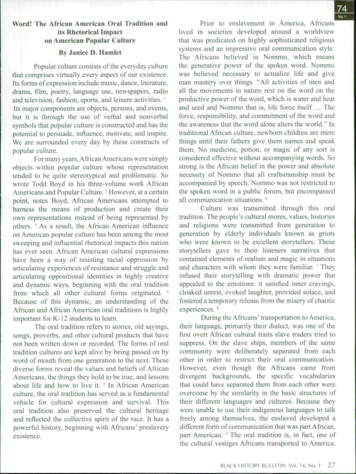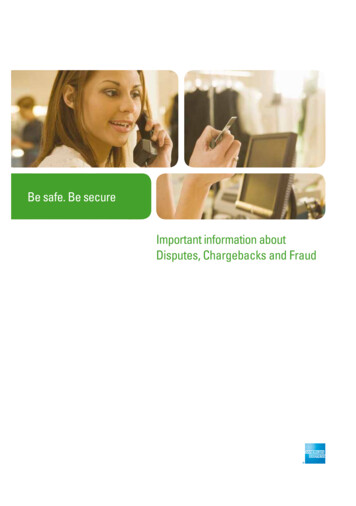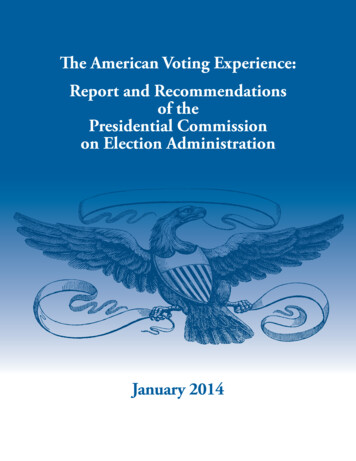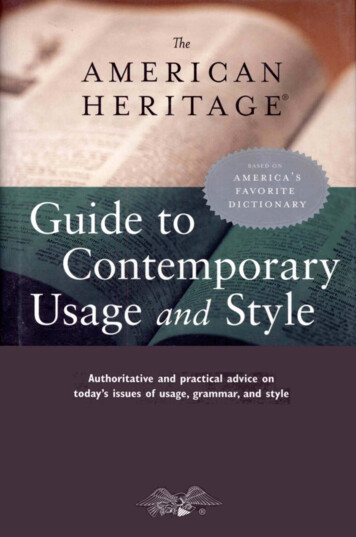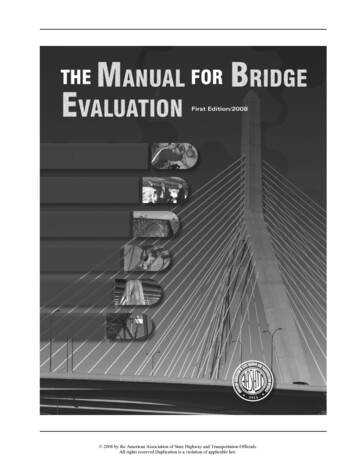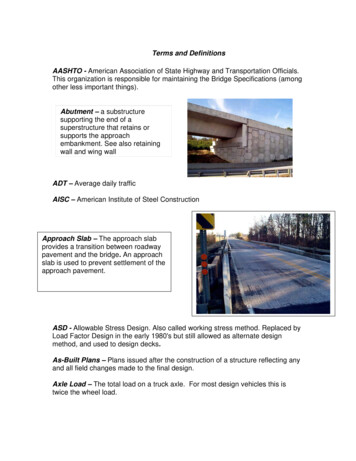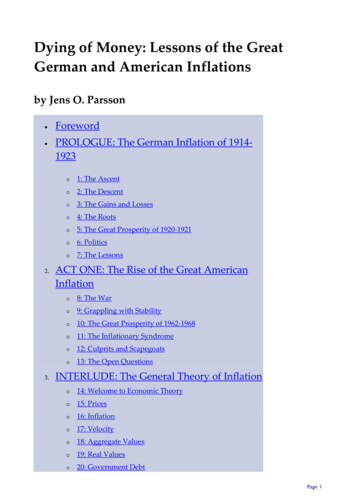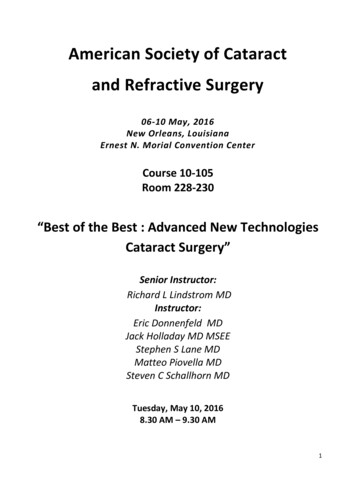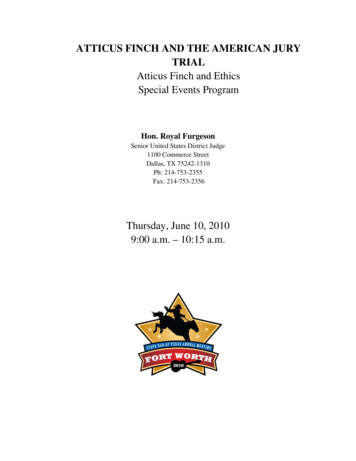
Transcription
ATTICUS FINCH AND THE AMERICAN JURYTRIALAtticus Finch and EthicsSpecial Events ProgramHon. Royal FurgesonSenior United States District Judge1100 Commerce StreetDallas, TX 75242-1310Ph: 214-753-2355Fax: 214-753-2356Thursday, June 10, 20109:00 a.m. – 10:15 a.m.
ROYAL FURGESONSENIOR UNITED STATES DISTRICT JUDGE1100 Commerce Street, Dallas, TX 75242-1310PH: 214-753-2355 FAX: 214-753-2356PERSONAL: Wife: Marcellene Malouf, Executive Director, DII Asbestos Trust, Dallas, TX Children: Kelly, Houston, Josh, Seth and Jill Stepchildren:Christina, Elizabeth, Katherine and JonathanEMPLOYMENT: U.S. Army from 1967-69 (attained rank of Captain; served year in Vietnam). Clerk for Honorable Halbert O. Woodward, U. S. District Judge, Lubbock, Texas, 1969-70. Shareholder, Law Firm of Kemp, Smith, Duncan & Hammond, El Paso, Texas, 1970-94. U. S. District Judge, Western District of Texas: El Paso Division, March 11, 1994 to March 1995; Midland Division,March 1995 to March 2003; San Antonio Division, March 2003 to November 2008. Senior U. S. District Judge, Northern District of Texas, December 2008 to present.EDUCATION: B.A. Degree, English, May 1964, Texas Tech University (Varsity Letter, Basketball, 1961-62; President, Student Body, 1963-64) J.D. Degree with Honors, May 1967, University of Texas School of Law (Associate Editor, Texas Law Review)AFFILIATIONS: Board Certified, Texas Board of Legal Specialization, Civil Trial Law, 1979-94. Texas Bar Foundation, 1981-present. American Law Institute, 1982-present. American College of Trial Lawyers, 1987-present. American Bar Foundation, 1993-present. Philosophical Society of Texas, 2000 to present.ACTIVITIES: El Paso County Child Welfare Board (Chair, 1977-78). University of Texas Law Alumni Association (President, 1978-1979). National Conference of Christians and Jews, El Paso Chapter (President 1978). El Paso United Way (General Campaign Chair 1979 and President 1981). El Paso Cancer Treatment Center (President 1980). El Paso Bar Association (President 1983). Keep El Paso Beautiful Association (President 1988). American Board of Trial Advocates, El Paso Chapter (President 1991). Judicial Resources Committee of the Judicial Conference of the United States (Chair 2005-2007). Judicial Panel on Multidistrict Litigation (2008-present).RECOGNITION: Outstanding Young Lawyer of El Paso, 1973. Faculty Award, University of Texas Law School, November 1983. Humanitarian Award, National Jewish Center for Immunology & Respiratory Medicine, May 1988. Hannah G. Solomon Award, El Paso Section, National Council of Jewish Women, February 1991. Community Service Award, University of Texas School of Law, April 1991. Honorary Degree, Cathedral High School, El Paso, Texas, 1994. Outstanding Jurist Award, El Paso Bar Association, May 1996. Leon Green Award, Texas Law Review, University of Texas School of Law, 2001. Nancy L. Garms Memorial Award, State Bar of Texas, 2003. Spirit of Excellence Award, American Bar Association, Commission on Racial and Ethnic Diversity, 2004. Judicial Appreciation Award, San Antonio Young Lawyers’ Association, 2004. Jurist of the Year, Texas Chapter of the American Board of Trial Advocates, 2004. Distinguished Alumnus, Texas Tech Alumni Association, 2007. West Texas Legal Legend, Texas Tech University School of Law, 2008. Standing Ovation Award, State Bar of Texas CLE, 2009.Printed March 11, 2010
The Jury in To Kill A MockingbirdWhat Went Wrong?State Bar ConventionFort Worth, TexasJune 10, 2010Royal Furgeson*United States District JudgeNorthern District of Texas, Dallas Division1.IntroductionHow could the jury in To Kill A Mockingbird 1 find Tom Robinson guilty? It isclear, beyond a reasonable doubt, that he was not guilty. How could that very jury ignorethe final argument of Atticus Finch? It was superb.Gentlemen, I shall be brief, but I would like to use my remaining time withyou to remind you that this case is not a difficult one, it requires no minutesifting of complicated facts, but it does require you to be sure beyond allreasonable doubt as to the guilt of the defendant. To begin with, this caseshould never have come to trial. This case is as simple as black and white.The state has not produced one iota of medical evidence to the effect thatthe crime Tom Robinson is charged with ever took place. It has reliedinstead upon the testimony of two witnesses whose evidence has not onlybeen called into serious question on cross-examination, but has been flatlycontradicted by the defendant. The defendant is not guilty, but somebodyin this courtroom is.I have nothing but pity in my heart for the chief witness for the state, butmy pity does not extend so far as to her putting a man’s life at stake, whichshe has done in an effort to get rid of her own guilt.I say guilt, gentlemen, because it was guilt that motivated her. She hascommitted no crime, she has merely broken a rigid and time-honored code*I want to thank my law clerks, Erin Higginbotham and Joshua Barron, for their help inpreparing this paper.1HARPER LEE, TO KILL A MOCKINGBIRD 215-18 (J. B. Lippincott Company) (1960).1
of our society, a code so severe that whoever breaks it is hounded from ourmidst as unfit to live with. She is the victim of cruel poverty andignorance, but I cannot pity her: she is white. She knew full well theenormity of her offense, but because her desires were stronger than the codeshe was breaking, she persisted in breaking it. She persisted, and hersubsequent reaction is something that all of us have known at one time oranother. She did something every child has done—she tried to put theevidence of her offense away from her. But in this case she was no childhiding stolen contraband: she struck out at her victim—of necessity shemust put him away from her—he must be removed from her presence, fromthis world. She must destroy the evidence of her offense.What was the evidence of her offense? Tom Robinson, a human being.She must put Tom Robinson away from her. Tom Robinson was her dailyreminder of what she did. What did she do? She tempted a Negro.She was white, and she tempted a Negro. She did something that in oursociety is unspeakable: she kissed a black man. Not an old Uncle, but astrong young Negro man. No code mattered to her before she broke it, butit came crashing down on her afterwards.Her father saw it, and the defendant has testified as to his remarks. Whatdid her father do? We don’t know, but there is circumstantial evidence toindicate that Mayella Ewell was beaten savagely by someone who ledalmost exclusively with his left. We do know in part what Mr. Ewell did:he did what any God-fearing, persevering, respectable white man would dounder the circumstances—he swore out a warrant, no doubt signing it withhis left hand, and Tom Robinson now sits before you, having taken the oathwith the only good hand he possesses—his right hand.And so a quiet, respectable, humble Negro who had the unmitigatedtemerity to ‘feel sorry’ for a white woman has had to put his word againsttwo white people’s. I need not remind you of their appearance and conducton the stand—you saw them for yourselves. The witnesses for the state,with the exception of the sheriff of Maycomb County, have presentedthemselves to you gentlemen, to this court, in the cynical confidence thattheir testimony would not be doubted, confident that you gentlemen wouldgo along with them on the assumption—the evil assumption—that allNegroes lie, that all Negroes are basically immoral beings, that all Negromen are not to be trusted around our women, an assumption one associateswith minds of their caliber.2
Which, gentlemen, we know is in itself a lie as black as Tom Robinson’sskin, a lie I do not have to point out to you. You know the truth, and thetruth is this: some Negroes lie, some Negroes are immoral, some Negromen are not to be trusted around women—black or white. But this is atruth that applies to the human race and to no particular race of men. Thereis not a person in this courtroom who has never told a lie, who has neverdone an immoral thing, and there is no man living who has never lookedupon a woman without desire.One more thing, gentlemen, before I quit. Thomas Jefferson once said thatall men are created equal, a phrase that the Yankees and the distaff side ofthe Executive branch in Washington are fond of hurling at us. There is atendency in this year of grace, 1935, for certain people to use this phraseout of context, to satisfy all conditions. The most ridiculous example I canthink of is that the people who run public education promote the stupid andidle along with the industrious—because all men are created equal,educators will gravely tell you, the children left behind suffer terriblefeelings of inferiority. We know all men are not created equal, in the sensesome people would have us believe—some people are smarter than others,some people have more opportunity because they’re born with it, some menmake more money than others, some ladies make better cakes than others—some people are born gifted beyond the normal scope of most men.But there is one way in this country in which all men are created equal—there is one human institution that makes a pauper the equal of aRockefeller, the stupid man the equal of an Einstein, and the ignorant manthe equal of any college president. That institution gentlemen, is a court. Itcan be the Supreme Court of the United States or the humblest J.P. court inthe land, or this honorable court which you serve. Our courts have theirfaults, as does any human institution, but in this country our courts are thegreat levelers, and in our courts all men are created equal.I’m no idealist to believe firmly in the integrity of our courts and in the jurysystem—that is no ideal to me, it is a living, working reality. Gentlemen, acourt is no better than each man of you sitting before me on this jury. Acourt is only as sound as its jury, and a jury is only as sound as the menwho make it up. I am confident that you gentlemen will review withoutpassion the evidence you have heard, come to a decision, and restore thisdefendant to his family. In the name of God, do your duty. 22LEE, supra note 1, at 215-18.3
2.A Non-Diverse JuryThe simple answer to the question posed at the beginning of this paper is that theMockingbird jury was not representative of Maycomb County, Alabama in 1935. Whilethat jury had no women and it had no minorities, we are certain that Maycomb Countyhad lots of both.Rather than being diverse, by gender, race and ethnicity, it wasmonochromatic, populated by 12 white men. Scout describes the jury as “[s]unburned,lanky, they seemed to be all farmers, but this was natural: townsfolk rarely sat on juries,they were either struck or excused. One or two of the jury looked vaguely like dressedup Cunninghams.” 3Scout’s description confirms what history tells us about the composition of juriesat that time: all white, all men. I believe it was this lack of diversity that prevented theMockingbird jury from providing Tom Robinson with his guaranteed right to a fair trial“by an impartial jury of the State.” 4As history teaches us “[t]he diverse and representative character of the jury mustbe maintained “‘partly as assurance of a diffused impartiality and partly because sharingin the administration of justice is a phase of civic responsibility.’” 5 The Supreme Courtheld in 1879 in Strauder v. West Virginia, 6 that the Fourteenth Amendment forbids a stateto bar men from jury pools based on race or color. But in 1935 our country, especially instates like Alabama, still had far to go before juries and our courts would truly be “the3LEE, supra note 1, at 175.U.S. Const. Amend. VI (emphasis added).5Taylor v. Louisiana, 419 U.S. 522, 530-31 (1975) (quoting Thiel v. Southern PacificCo., 328 U.S. 217, 227 (1946) (Frankfurter, J., dissenting).6100 U.S. 303 (1879).44
great levelers” that Atticus Finch envisioned. 7 In fact, one might argue that we still havequite a distance to go to reach his ideals. More on this later, but first let us remember thelong fight to make juries representative.3.Discrimination Against Racial Minorities in Jury SelectionA.African-AmericansFor over a century, racial minorities have, as a legal matter, been protected againstjury discrimination, but in practice these legal protections provided little actual protectionuntil recently. Congress enacted a law in 1875 making it a crime to engage in racialdiscrimination. 8 But there has only been a single recorded prosecution under this statutedespite a long history of racial jury discrimination in the South. 9The Supreme Court first dealt with the question of whether minorities couldprotect their own rights against discrimination in 1879 in Strauder. Justice Strong wrotethe Court’s opinion as it considered an 1873 West Virginia statute which limited juryservice to white males over the age of twenty-one who were not elected officials.10Justice Strong found that singling out African-Americans from service as jurors was“practically a brand upon them” and that it served to prevent “equal justice which the lawaims to secure to all others.” 11 Accordingly, the Court struck down the statute because it7LEE, supra note 1, at 218.See 18 U.S.C. § 243.9See Michael Meltsner, Equality and Health, 115 U. PA. L. REV. 22, 22 n.2 (citing Exparte Virginia, 100 U.S. 339 (1880) as the only recorded prosecution under the statute).10Strauder, 100 U.S. at 305.11Id. at 308.85
“excluded every man of [the defendant’s] race, because of color alone, however wellqualified in other respects.” 12But Justice Strong’s final qualification would prove to be a useful weapon forthose seeking to exclude racial minorities. Indeed, the exception swallowed the generalrule:We do not say that within the limits from which it is not excluded by theamendment a State may not prescribe the qualifications of its jurors, and inso doing make discriminations. It may confine the selection to males, tofreeholders, to citizens, to persons within certain ages, or to persons havingeducational qualifications. We do not believe the Fourteenth Amendmentwas ever intended to prohibit this. Looking at its history, it is clear it had nosuch purpose. Its aim was against discrimination because of race or color. 13The degree to which the Supreme Court was willing to let racial minorities be excludedfrom juries is especially telling when one considers Justice Strong’s earlier description ofAfrican-Americans:The colored race, as a race, was abject and ignorant, and in that conditionwas unfitted to command the respect of those who had superiorintelligence. Their training had left them mere children, and as such theyneeded the protection which a wise government extends to those who areunable to protect themselves. They especially needed protection againstunfriendly action in the States where they were resident. It was in view ofthese considerations the Fourteenth Amendment was framed and adopted. 14Thus, while the Supreme Court would not allow states to use race as the basis forexclusion, it appeared to have no qualms with other qualification requirements whichcould have the same effect given the Supreme Court’s view that African Americans were12Id. at 309.Id. at 310.14Id. at 306.136
generally “abject and ignorant.” 15 Decided the same day as Strauder, Commonwealth ofVirginia v. Rives 16 would help narrow even more the limited effectiveness of Strauder.Justice Strong found that there was no Fourteenth Amendment violation when anAfrican-American defendant was faced with the prospect of an all-white jury. 17 Rather,an African-American defendant’s right was the same as any other citizen: that jurorswould be selected based on various qualifications with “no discrimination against thembecause of their color.” 18 The Rives defendants had not properly alleged a FourteenthAmendment violation even though Justice Strong admitted that the defendants did allege:[T]hat the grand jury by which the petitioners were indicted, as well as thejury summoned to try them, were composed wholly of the white race, andthat their race had never been allowed to serve as jurors in the county ofPatrick in any case in which a colored man was interested, fall short ofshowing that any civil right was denied, or that there had been anydiscrimination against the defendants because of their color or race. Thefacts may have been as stated, and yet the jury which indicted them, and thepanel summoned to try them, may have been impartially selected. 19Notwithstanding the hurdles that Justice Strong put in the way of AfricanAmericans challenging all-white juries in Rives, the Court’s decision in Strauder was metby strong opposition in the South. William Royall, a well-known Virginia lawyer wrotein his magazine, Commonwealth, that the Strauder decision amounted to a completeoverthrow of federalism and a continuation of the Reconstruction.15Id.100 U.S. 313 (1879).17Id. at 322.18Id. at 323.19Id. at 322.167
[I]t was not supposed that [the Fourteenth Amendment] would ever receivethe wide construction now given to it [in Strauder], yet thinking menlooked upon its provisions with alarm, until [the decision in The SlaughterHouse Cases 20]. . . . This same Republican [C]ourt sees now . . . that thelimitation which its decision put upon the powers of Congress, so . . . freedthe country from congressional domination as that the Democrats are aboutto take possession of the Government. It has, therefore, made the decisionsthat were rendered on Monday. These decisions mean that the RepublicanParty intend[s] to hold on to the reins of Government . . . . They are acomplete overthrow of our Constitutions. 21After Strauder, minorities could not be excluded from juries solely on account oftheir race, provided that a law prohibited service. In Neal v. Delaware 22 the SupremeCourt took up the issue considered in Rives: could a state exclude all African-Americansin practice even if the laws permitted jury service. All lower courts had dismissed thedefendants’ claims, because they found no state law or constitutional provision currentlyin force that excluded African-Americans. 23 This time, Justice Harlan’s opinion appearedto leave much less leeway for discrimination. In Neal, no African-American juror hadeven been summoned from 1870 to 1880, let alone actually served at a trial. 24 JusticeHarlan found that in the face of these facts the state court’s refusal to grant relief to thecriminal defendant was:2083 U.S. 36 (1873).Benno C. Schmidt, Jr., Juries, Jurisdiction, and Race Discrimination: The LostPromise of Strauder v. West Virginia, 61 TEX. L. REV. 1401, 1447 n.227 (quotingFairman, Reconstruction and Reunion, 1864-1888, in 6 HISTORY OF THE SUPREMECOURT OF THE UNITED STATES, 1374 (P. Freund ed. 1971).22103 U.S. 370 (1880).23Id. at 387.24Neal, 100 U.S. at 397.218
[A] violent presumption . . . that such uniform exclusion of that race fromjuries, during a period of many years, was . . . fairly exercised, [because]the black race in Delaware were utterly disqualified, by want ofintelligence, experience, or moral integrity, to sit on juries. The action ofthose officers in the premises is to be deemed the act of the State; and therefusal of the State court to redress the wrong by them committed was adenial of a right secured to the prisoner by the Constitution and laws of theUnited States. 25Thus, Neal prohibits state officials from barring minority service on juries evenwhen there is no law that bans certain classes of individuals from serving on juries basedon racial grounds. But it is easy to overstate the strength of Neal. Delaware conceded inNeal that African-Americans had never served as a juror in the entire State of Delaware. 26Thus, the defendants in Neal were allowed to argue in federal court only because theSupreme Court saw how openly hostile to African-Americans the Delaware courtswere. 27 Justice Har
ROYAL FURGESON SENIOR UNITED STATES DISTRICT JUDGE 1100 Commerce Street, Dallas, TX 75242-1310 PH: 214-753-2355 FAX: 214-753-2356 PERSONAL: Wife: Marcellene Malouf, Executive Director, DII Asbestos Trust, Dallas, TX

